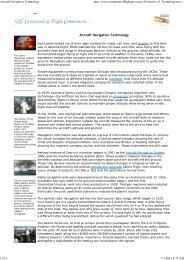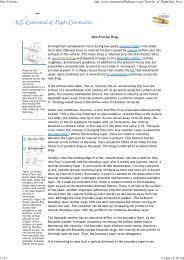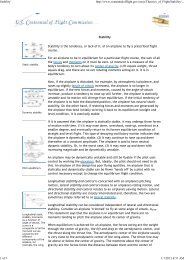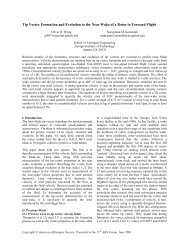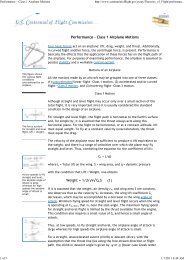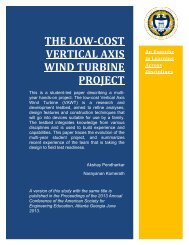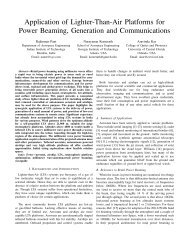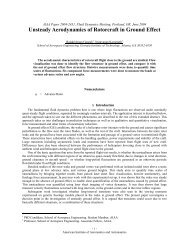competition. Today, it is becoming evident that <strong>the</strong> success of engineering in o<strong>the</strong>rcountries such as Japan, China <strong>and</strong> India may be due not just to “cheap labor” but also to“better product <strong>for</strong> <strong>the</strong> money”. This has occurred in one industry after ano<strong>the</strong>r,exemplified by <strong>the</strong> evolution of Japanese automobiles from <strong>the</strong>ir “reputation” <strong>for</strong> cheap,flimsy vehicles, to dominance of objective quality rankings. The same occurred in <strong>the</strong>semiconductor industry. Similar developments are becoming evident in <strong>the</strong> Europeanaerospace industry, which has proved to be faster at adopting technical innovations intoadvanced products than <strong>the</strong>ir American counterparts.The implications to engineering education are yet to be realized – but it is evident fromexperience that engineers graduating from o<strong>the</strong>r nations are quite well-prepared to succeed inAmerican graduate schools. Today it is also becoming evident that uncompromising emphasis onma<strong>the</strong>matical reasoning <strong>and</strong> analytical ability are keys to implementing innovations in advancedtechnology. Graduates from <strong>the</strong> leading European <strong>and</strong> Asian institutions come with superbma<strong>the</strong>matical skills. The superstitions which held that <strong>for</strong>eign schools teach rote learning <strong>and</strong>imitation, while we teach analytical thinking <strong>and</strong> innovation, are debunked by quantitative <strong>and</strong>qualitative evidence.Integrating Industry <strong>and</strong> <strong>University</strong> ViewpointsIn Table 1, we try to summarize <strong>the</strong> major issues that faced industry <strong>and</strong> universities over <strong>the</strong>years. Certainly, issues crossed <strong>the</strong>se pigeonholes, but <strong>the</strong>re are some general trends that gotmore attention in different periods. Over <strong>the</strong> years, <strong>the</strong>re has been increasing communication <strong>and</strong>better underst<strong>and</strong>ing of perspectives, though this is not to claim that <strong>the</strong>re has been, or will oreven need be, total alignment. Table 1 is an attempt to summarize <strong>the</strong> evolution of issuesin<strong>for</strong>mally – no claim is made that <strong>the</strong>se perceptions of issues are generally endorsed.Table 1: Evolution of IssuesPeriod Industry UniversitiesMid- Cold WarResearch vs. Instruction‘80sLate80sEarly90sTransition from mass-producedplat<strong>for</strong>ms to multiple projects <strong>and</strong>small production runs.Total Quality Management.Team project environments.Mid’90s Gulf War 1. Market responsiveness,Production efficiency. Work<strong>for</strong>cefluctuation. Internet revolution.Late‘90s.Dotcom boom. Worker shortage.Global competition starts.Increase design content in curriculum.Developing teaching metrics.Curricular re<strong>for</strong>m initiatives; “ScholarshipRedefined”. Experiential learning.Experiments with new types of curricula.Internet revolution. Integration of pedagogyresearch into university instruction.System lifecycle simulation. Systems designcurricula.Proceedings of <strong>the</strong> 2005 American Society <strong>for</strong> Engineering Education Annual Conference & ExpositionCopyright ASEE 2005, American Society <strong>for</strong> Engineering Education.
Early00sRecession. Terrorism & securityissues. War economy. Drop inglobal dem<strong>and</strong>. Loss of corporatememory.Mid 00s Cost-cutting; stiff globalcompetition. Making money onR&D; small-group environments.Knowledge retention & transfer.2010s? Large-scale distributed projects.LSI. Outsourcing design as well asproduction.Cross-disciplinary research. Emphasis onnano-systems, biotechnology. Undergraduateresearch participation. New ABET criteriafocus on self-assessment.Distance learning. Questions about role of USeducation system. Assessment tools <strong>and</strong>practices.More choice in curricula. Diverse tracks <strong>and</strong>career choices. Need <strong>for</strong> substantial “societal”issue experience in engineering education.The <strong>Boeing</strong> Welliver program, over <strong>the</strong> years, has been very effective in bridging majordisagreements <strong>and</strong> building <strong>the</strong> confidence needed to institute effective <strong>and</strong> well-focusedchanges. We surveyed <strong>the</strong> “Welliver Alumni” (107 to-date) with 5 questions, shown at left. Theresponses are discussed below. First, some general observations from <strong>the</strong> responses.Questions e-mailed to <strong>the</strong> Alumni of <strong>the</strong> Welliver Summer• The Welliver program focused onFaculty Fellowship program, January 2005.1.How has WFSF influenced your relations with industry? individual teaching faculty, ra<strong>the</strong>r than2.How has WFSF influenced <strong>the</strong> curriculum?administrators, as ambassadors of3.How has WFSF influenced your personal philosophy as change.educator?• It impressed faculty with its depth <strong>and</strong>4.What do you see as <strong>the</strong> top 3 issues <strong>for</strong> <strong>the</strong> future ofbreadth of corporate commitment. Theengineering education today?5. Are <strong>the</strong>se <strong>the</strong> right questions? If not, please suggest <strong>the</strong> opportunity to discuss issues withright questions.senior corporate talent was valued.• The intensity <strong>and</strong> breadth of <strong>the</strong> 8-How has WFSF influenced your relations withweek individual experience, as well asindustry?“learning through colleagues’ eyes”Better appreciation of how industry operates, <strong>and</strong> what is that came from comparing notes withvalued <strong>the</strong>re. Ongoing interactions with <strong>Boeing</strong>. Enhanced<strong>the</strong> team, enabled a deeply impressiveunderst<strong>and</strong>ing <strong>and</strong> credibility in dealing with o<strong>the</strong>rcompanies. Better underst<strong>and</strong>ing of how to frame research experience.issues.• Curiosity about <strong>the</strong> approaches takenby one’s teammates, given <strong>the</strong> sameHow has WFSF influenced <strong>the</strong> curriculum?problem definition <strong>and</strong> similarCreation of “Systems Engineering” courses <strong>and</strong> even constraints, turned into strongentire curricula. Incorporation of “lean” ideas, “practical friendships. That <strong>the</strong>re was no real callin<strong>for</strong>mation”, communication exercises, schedule <strong>and</strong> costconcerns <strong>and</strong> case studies into courses. Multidisciplinary<strong>for</strong> “competition” beyond <strong>the</strong>team projects. Ideas from Integrated Product Teams.imperative of contributing one’s bestIncreased interest in design. Lower-division introduction as a team member, is an extremelycourses <strong>for</strong> perspective. Exp<strong>and</strong>ed elective choices.important facilitator of this experienceRein<strong>for</strong>cement of ideas.• It focused on <strong>the</strong> most importantaspect of <strong>the</strong> teacher’s profession –deciding how <strong>and</strong> what to teach <strong>the</strong>ir students, providing expert support in a team setting.• Beyond this support, it left <strong>the</strong> freedom to plan <strong>and</strong> implement in <strong>the</strong> h<strong>and</strong>s of <strong>the</strong> teacher,without pressure <strong>for</strong> short-term demonstrations.• It continued to articulate a consistent message <strong>for</strong> a decade.Proceedings of <strong>the</strong> 2005 American Society <strong>for</strong> Engineering Education Annual Conference & ExpositionCopyright ASEE 2005, American Society <strong>for</strong> Engineering Education.



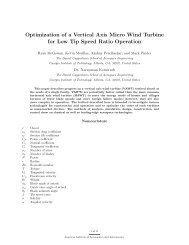
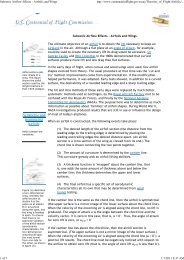

![p density of fluid, kg/m3 [Greek letter rho] V mean velocity of fluid, m ...](https://img.yumpu.com/50595898/1/184x260/p-density-of-fluid-kg-m3-greek-letter-rho-v-mean-velocity-of-fluid-m-.jpg?quality=85)
